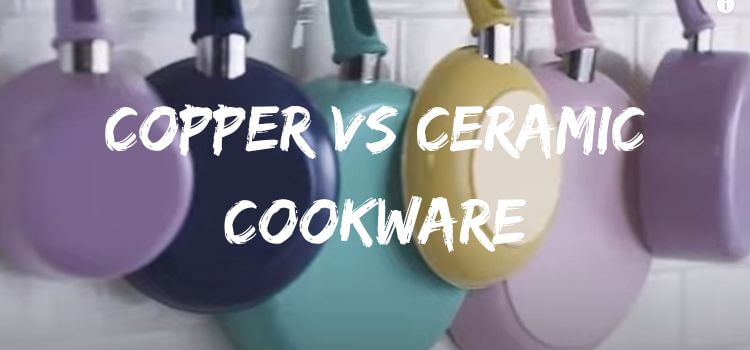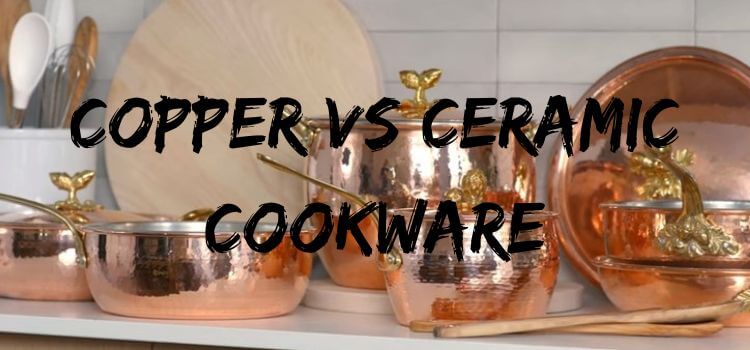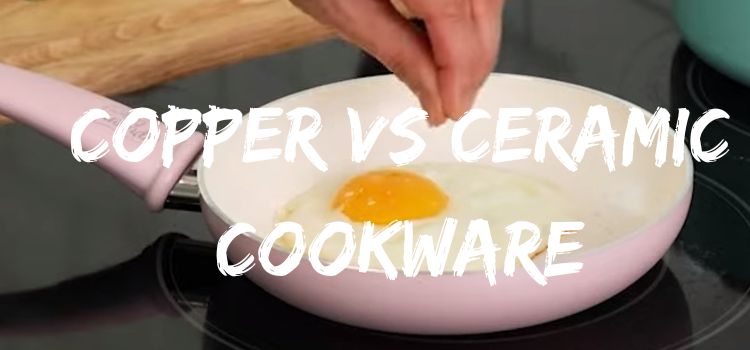As an Amazon Associate, I earn from qualifying purchases.
As an Amazon Associate, I earn from qualifying purchases
There is a wide variety of cookware and styles to suit any family’s needs. Many people feel overwhelmed by all the options when looking for new cookware. Plenty of cookware is available, each with its unique characteristics and uses.
People tend to like two distinct kinds of cookware: copper and ceramic. You can find both in most kitchens, and it’s clear that they both have their advantages and disadvantages.

Although copper’s conductivity is well-known, it is safe when not combined with hazardous or otherwise hazardous materials.
Important Points:
- Copper cookware has the advantage of rapid heating and cooling and equal heat distribution, but it needs more care to prevent tarnishing.
- Ceramic cookware is simple to clean, non-reactive, and dishwasher safe, but it may not heat uniformly and is prone to chipping and cracking with repeated use.
- Since both cookware has advantages and disadvantages, the decision primarily concerns individual tastes and tasks.
Copper Cookware vs Ceramic:
Copper cookware has an aluminum core and a ceramic nonstick coating that mimics the color of copper. It can heat up quickly. Molded into specific shapes, ceramics are created by combining clay with other earthy materials, powders, and water. Not only is it heavier, but it heats the material slowly and is oven and dishwasher-safe.
A copper pot is an example of copper cookware. Because this material is entirely impervious to corrosion, long-lasting, and completely hygienic, these pots are perfect for heat conductivity.
Beyond this, it’s well known that copper is an excellent material for kitchen appliances due to its high heat conductivity.
Cookware is mainly made of copper but has a ceramic covering, known as ceramic cookware. This one has a ceramic coating, unlike other nonstick cookware made of metals like stainless steel or aluminum. This ceramic coating has no trace of Teflon or any other heavy metal.
What is copper cookware?
A pot crafted from copper is known as copper cookware. These pots are perfect for heat conductivity since the material is impervious to corrosion, long-lasting, and completely sanitary.
Aside from all that, copper is an excellent material for any kitchen device since it is a good heat conductor.

Copper cookware is highly regarded for its superior heating technique and sleek, professional appearance, two of its most appealing features.
But aside from that, individuals might prefer something other than copper cookware for several reasons. First, it can easily leach into food, especially when there’s a lot of it. Second, when cooked, it reacts quickly with acidic and alkaline foods, giving them a metallic aftertaste.
What is ceramic cookware?
Copper is the primary material used to make ceramic cookware, which is essentially cookware with a coating of ceramic on it. The ceramic layer makes it different from stainless steel, aluminium, and other nonstick cooking materials. Teflon and any other heavy metals are not present in any way, shape, or form in this ceramic coating material.

Ceramic cookware has been in high demand for several years now, and the primary reasons for this demand are as follows: Ceramic pots and pans come in many colours, so you can choose the one you like best. They are also very easy to clean.. Ceramic cookware allows food to be stored securely and efficiently, and it can be used at a later time; and the most important reason for us is that ceramic cookware is entirely safe to use in the dishwasher.
Even though a few factors cause individuals to reconsider purchasing them, the most common ones are that food can quickly become stuck in them, that they are not exceptionally sturdy, and that they chip quickly.
Main Differences Between Copper Cookware and Ceramic
- The primary distinction between copper and ceramic cookware is that the ceramic material is heated relatively slowly. In contrast, the copper cookware has a relatively rapid heating process.
- Ceramic cookware is made of copper and has a ceramic coating on it, while copper cookware is made of copper and has a ceramic coating on it.
- Copper cookware has a hazardous substance, so it is used cautiously. On the other hand, ceramic cookware is entirely free of Teflon and any other heavy metal.
- Copper is one of the best conductors of heat and is ideal for any kitchen appliance. Ceramic ones, on the other hand, are straightforward and convenient to clean, and they come in a variety of colors, giving you the option to choose among them.
- Copper has the potential to seep into the food readily, and this can happen in a significant quantity. Ceramic containers, on the other hand, are short-lasting and are prone to chipping with time.
What they have in common:
Copper and ceramic should not be used for induction cooking since they are incompatible. Copper is a nonmagnetic and nonferrous type of metal.
It is possible to dispose of both materials in facilities that are dedicated to recycling cookware.
Ceramic is resistant to corrosion. Copper, on the other hand, does not rust, but it does tarnish when it is exposed to air.
Both kinds should be washed by hand using procedures that do not involve abrasion and then dried by hand.
Each of the two categories offers a comparable selection of cookware parts.
If you take care of them, both will last forever.
Comparison Table:
| Parameters of Comparison | Copper Cookware | Ceramic Cookware |
|---|---|---|
| Material | Copper is the only material that they are constructed of. | The cookware constructed of ceramic has a ceramic covering on it, even though it is composed of copper. |
| Heat | They are skilled in the operation of their heating system. | Although the heating process is sluggish, it ensures food is uniformly cooked. |
| Toxic material | Considering that copper cookware contains a certain amount of poisonous substances, it is essential to exercise caution when using it. | Ceramic is entirely devoid of Teflon and any other materials that contain heavy metals. |
| Pros | Copper is one of the best materials for conducting heat, making it an excellent choice for kitchen equipment. | They are straightforward and trouble-free to clean and come in a wide range of colours, allowing you to select the one that best suits your needs. |
| Cons | It is possible for copper to seep into the food; when it does, it is in vast quantities. | Due to their nature, they are short-lasting and readily chipped. |
A Few Brands for Copper Cookware:
- Mauviel Cuprinox (Copper with inner stainless steel lining)
- All-Clad Copper Core (Stainless steel clad copper)
- Made In Copper (with a stainless steel clad interior, crafted in France)
- Ruffoni, an Italian cookware brand
A Few Brands for Ceramic Cookware:
- T-fal Initiatives Ceramic Cookware Set
- GreenPan Swift Healthy Ceramic Cookware Set
- Ninja Extended Life Premium Ceramic Cookware Set
- KitchenAid Hard Anodized Ceramic Cookware Set
That’s it for now. Please leave a comment on how the post was helpful for you.
Related Topic:
Ceramic vs. Granite Cookware. porcelain vs. ceramic cookware.
Amazon and the Amazon logo are trademarks of Amazon.com, Inc. or its affiliates.
Leave a Reply